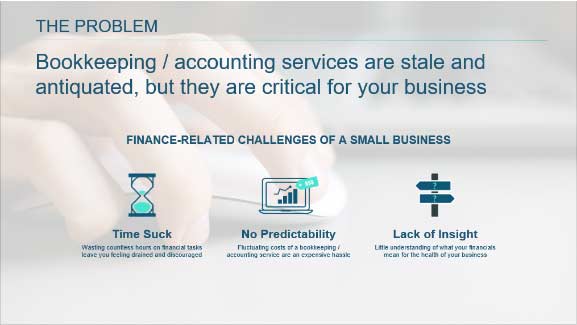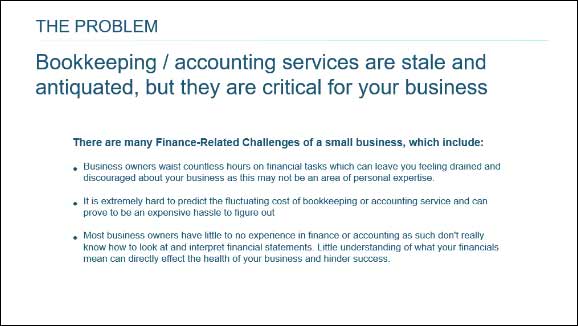What is a Pitch Deck?
Every business has a story; use your pitch deck to tell that story in a clear and compelling way. Pitch decks should be a convincing presentation of the problem your company is solving, while also being highly engaging and entertaining. These tips will help you build pitch decks to attract and maintain interest from investors.
Different Types of Pitch Decks
We always recommend that business owners have two versions of their pitch deck:
- In-Person Pitch Deck. This is your main pitch deck and is intended to be narrated live. The in-person pitch deck is shorter than the standalone version and should include very visual, concise slides that supplement the verbal story you are telling your audience.
- Standalone Pitch Deck. The second version of your deck is significantly longer. This standalone variant includes all of your key talking points and tells your company’s story without any narration. This is the deck left behind after a meeting or sent directly to an investor before an in-person meeting.
Engage the Audience
The most important part of any pitch deck is selling your vision to your audience. You need to hook your audience from the first slide and keep them highly engaged throughout your pitch. Often, a good hook opens with an anecdotal story that highlights the problem your company is going to solve. This creates an emotional connection between you and the audience. Now that you have their attention, it’s your job to keep them engaged for the rest of your pitch.
Entrepreneurs and business owners are highly passionate about their businesses and are intimately familiar with every aspect of their companies. Therefore, many pitches are way too detailed and an exhausting number of slides. If your pitch is too long, you’ll lose your audience and their interest in helping you. Keep pitches to about 10-15 highly visual and highly focused slides and limit each slide to only one idea.
Keep it Visual
Good imagery helps your audience retain your message and also keeps them engaged. Unless you want eyes to glaze over and attentions to wane, don’t present text-heavy slides. Plus, elegant slides with powerful imagery look extremely professional and lend credibility to your ideas.
Do This:

Not This:

Pitch Deck Flow
It’s crucial to tell a cohesive story during your entire pitch. You want to take your audience on a journey so they can empathize with the problem you’ve identified and envision the solution your company offers. We follow the outline below for every pitch deck we build our clients:
- Tell a Story. Intrigue the audience with personal anecdotes about the problem .
- The Problem: Explain the problem that you have identified in the market and make it relatable to your audience. Again, use anecdotes / case studies.
- The Solution / Your Company: Describe your solution and how it is different than current solutions. Explain why you / your team are uniquely positioned to solve the market’s demands.
- The Company: Introduce your company and explain how it is best positioned to solve the problem.
- The Market: In detail, describe the market landscape or outlook, identify the total addressable market size, and project your expected market penetration.
- The Competition: What are the alternative solutions to the problem you are trying to solve? Explain who your competitors are and the advantages you have over them.
- The Numbers: show 1-to-3 year revenue projections with margins and cost structure using a financial model. Tell investors how you will spend the money you hope to raise.
- The Team: Introduce your key team members and sell your audience on why the team’s expertise / past experiences will lead to success.
- The Ask: The last and most important slide lets your audience know what you are asking for. Tell them why they just sat through your pitch deck and what you are looking to get from them. If you are trying to raise a $500,000 convertible note, state that, as well as your terms around the note. Make it clear and easy to understand.
Practice telling your story
Once your pitch deck is built, practice out loud so that your verbal pitch flows seamlessly with your slides. To avoid sounding scripted, make sure you come prepared knowing and understanding the data and metrics behind your business plan. Moreover, the audience will undoubtedly ask questions about your business plan. Anticipate these questions and prepare thoughtful answers. If you don’t know or have a good answer, it’s fine to say so and follow up the next day. Before your first pitch deck, practice in front of the mirror -and in front of friends and family-. Speaking eloquently and having confidence are key to winning your audience’s trust. Whatever you do, though, don’t sound like a scripted robot.
Key Takeaways:
DOs:
- Tell a story and engage people emotionally
- Limit each slide to one idea
- Prepare to make a great first impression
- Keep your slides clean and visually appealing
- Keep design consistent
- Know your metrics better than anyone
- Practice, practice, practice!!!
DON’Ts:
- Use too many bullet points
- Make it too long
- Read word by word from the slides
- Create a text-heavy presentation
- Come unprepared
- Use small font









